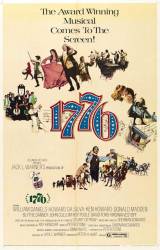Corrected entry: The real Caesar Rodney was nowhere near as decrepit as portrayed in the film. Additionally, he was not gnomelike, but was tall and thin as reported by John Adams in a letter to Abigail. Also, even though he did have skin cancer on his cheek which he covered with a scarf, he was not dying of it, and in fact, lived for eight years after the signing, and indeed until after the Treaty of Paris (1783) recognized American Independence. Rodney was actually suffering that summer, but it was from asthma exacerbated by the heat "in foul, fetid, fuming, foggy, filthy Philadelphia." Nonetheless, the reason for his absence from Congress was not his ill-health. As head of the Delaware Militia, he had been called away to deal with a Tory riot against Independence.
Corrected entry: When Secretary Thomson says that all members are present with the following exceptions: Paine, Gerry, Samuel Adams, Morton, Wythe, Richard H. Lee, New Jersey. More were missing: Carter Braxton (VA), William Ellery (RI), William Floyd and Philip Livingston (all NY), Francis Lee (VA), most of the Pennsylvania delegates, Matthew Thornton (NH), William Williams (CT), New Jersey came later, and 2 were missing: Abraham Clark and John Hart.
Correction: This film is not intended to be a historical documentary. Although the film (based on the Broadway musical comedy) is based on real events and real people, some of the characters and events have been changed or left out for dramatic/comedic purposes. This is called artistic license.
Corrected entry: During the alterations frenzy, Reverend Witherspoon states, "Nowhere do you mention the Supreme Being." and proposes the addition of the phrase "With a firm reliance on the protection of divine Providence." While this clause actually is an addition to Jefferson's final draft, the reasoning, as shown in the film, is wrong.
Correction: This film is not intended to be a historical documentary. Although the film (based on the Broadway musical comedy) is based on real events and real people, some of the characters and events have been changed or left out for dramatic/comedic purposes. This is called artistic license.
Corrected entry: John Dickinson is shown desperately trying to block the Declaration right up to the final vote. In reality, however, Dickinson was not present at the final vote on the resolution; having been kept at home so as not to kill the Declaration.
Correction: This film is not intended to be a historical documentary. Although the film (based on the Broadway musical comedy) is based on real events and real people, some of the characters and events have been changed or left out for dramatic/comedic purposes. This is called artistic license.
Corrected entry: When Thomas McKean states that "In my case, hanging won't be so bad," this is incorrect. The signer Benjamin Harrison said that.
Correction: This film is not intended to be a historical documentary. Although the film (based on the Broadway musical comedy) is based on real events and real people, some of the characters and events have been changed or left out for dramatic/comedic purposes. This is called artistic license.
Corrected entry: Just before the signing, Stephen Hopkins states that he wants to "remember each man's face as he signs." The filmmakers screwed up. William Ellery, a delegate from Rhode Island, where Hopkins was from, said this. Ellery was not shown in the movie.
Correction: This film is not intended to be a historical documentary, hence the filmmakers did not "screw up." Although the film (based on the Broadway musical comedy) is based on real events and real people, some of the characters and events have been changed or left out for dramatic/comedic purposes.
Corrected entry: The film opens with John Adams meditating at the top of the high bell tower of Independence Hall in the year 1776. In reality, the tower was not added to the building until some years later.
Correction: Independence Hall's construction was begun in 1732 and completed in 1756.
Corrected entry: When the Declaration Committee is deciding who should actually write it, Robert Livingston declines because he will be leaving Philadelphia shortly. In fact Livingston was in New York at the time of the vote on Independence and did not sign the Declaration (although he was for it).
Correction: He may not have signed it but he WAS part of the committee to write it. http://www.ushistory.org/declaration/related/livingston_r.htm.
Corrected entry: After Jefferson's wife arrives, he appears briefly in the doorway then goes back inside and slams the door shut behind him. The 'brick' wall surrounding the door shakes violently, showing that it is not real brick, but just a flimsy set piece.
Correction: On close examination, it can be seen that it is the ivy on the brick wall that shakes, not the wall itself.
Corrected entry: When Adams wakes up on the staircase his hair is disheveled. But by the time the next song begins, it's perfectly neat again, even though he showed no evidence of fixing it.
Correction: If you watch the widescreen version on DVD, you'll see that John walks over to a horse trough and cleans himself up, including fixing his hair.
Corrected entry: In the film, the Continental Congress discusses changes in the Declaration of Independence before voting on whether or not to declare independence. In reality, they passed the Declaration and then discussed changes.
Correction: This series of events was changed intentionally, as not to bore the audience.






Correction: When the filmmakers choose to change the physical appearance, such as height and weight, of a real historical figure, as in the case of Caesar Rodney, it is a standard accepted movie convention. As to the matter of his ailments, the filmmakers do not claim this film to be a historical documentary, and as such, they are not obligated to be factually accurate. Chalk it up to artistic license.
Super Grover ★